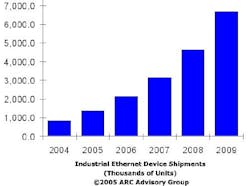Fast Growth Seen for Factory Ethernet
Industrial Ethernet networking technology has been proliferating at a rapid rate in recent years. And that growth shows no signs of stopping, according to recent research by ARC Advisory Group Inc., Dedham, Mass.
ARC projects the worldwide market for industrial Ethernet devices to grow at a 51.4 percent compound annual growth rate over the next five years. The market totaled 840,000 units in 2004, and will rise to just over 6.7 million units in 2009, according to ARC’s recently released “Industrial Ethernet Devices Market Outlook Study.” Among other things, the study includes revenue projections for industrial Ethernet switches, which are expected to grow at a 49.9 percent compound annual rate to $939.8 million in 2009, up from $124.4 million last year.
Among market drivers, ARC cites the lower cost of ownership that Ethernet provides to industrial users, along with improved adaptability for changing business requirements. Widespread availability and market familiarity is also helping drive wider use of industrial Ethernet.
Supplier upsets?
“Ethernet technology is rapidly penetrating the device level of the automation hierarchy. This provides one of those rare opportunities where a new technology can upset the supplier landscape,” says Ralph Rio, an ARC research director and principal author of the study. “Those suppliers who pay close attention to the market dynamics will benefit,” Rio adds.
The aggregate market for industrial Ethernet devices has grown substantially during the last few years despite a difficult market for automation equipment in most areas. The use of commercial off-the-shelf (COTS) technologies makes the application of Ethernet to industrial networking significantly easier for pilot projects, system extensions, application development and new automation systems, ARC points out.
But users must be careful. While some may start with a cheap office grade switch purchased at a local retail computer outlet, they soon learn the importance of reliability in an industrial environment, ARC says. One trip to the plant manager’s office to explain why a $30 home office switch brought down production becomes a hard lesson.
Process protection
Devices in a factory environment must be protected against factors including heat, vibration, power line noise and dust. Currently, nearly all industrial Ethernet switches are rated IP20 to IP40. But ARC forecasts an increase in the need for IP67 to IP68 ratings, as industrial networking expands deeper into process control applications for those industries where liquids are present.
ARC notes that the study did turn up a few surprises, in terms of user preferences for industrial Ethernet. An ARC user survey of industrial end users, for example, shows that price, while a consideration, is not a key differentiator for buyers.

